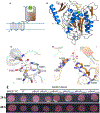Structural and Functional Characterization of the BcsG Subunit of the Cellulose Synthase in Salmonella typhimurium
- PMID: 30017920
- PMCID: PMC7020665
- DOI: 10.1016/j.jmb.2018.07.008
Structural and Functional Characterization of the BcsG Subunit of the Cellulose Synthase in Salmonella typhimurium
Abstract
Many bacteria secrete cellulose, which forms the structural basis for bacterial multicellular aggregates, termed biofilms. The cellulose synthase complex of Salmonella typhimurium consists of the catalytic subunits BcsA and BcsB and several auxiliary subunits that are encoded by two divergently transcribed operons, bcsRQABZC and bcsEFG. Expression of the bcsEFG operon is required for full-scale cellulose production, but the functions of its products are not fully understood. This work aimed to characterize the BcsG subunit of the cellulose synthase, which consists of an N-terminal transmembrane fragment and a C-terminal domain in the periplasm. Deletion of the bcsG gene substantially decreased the total amount of BcsA and cellulose production. BcsA levels were partially restored by the expression of the transmembrane segment, whereas restoration of cellulose production required the presence of the C-terminal periplasmic domain and its characteristic metal-binding residues. The high-resolution crystal structure of the periplasmic domain characterized BcsG as a member of the alkaline phosphatase/sulfatase superfamily of metalloenzymes, containing a conserved Zn2+-binding site. Sequence and structural comparisons showed that BcsG belongs to a specific family within alkaline phosphatase-like enzymes, which includes bacterial Zn2+-dependent lipopolysaccharide phosphoethanolamine transferases such as MCR-1 (colistin resistance protein), EptA, and EptC and the Mn2+-dependent lipoteichoic acid synthase (phosphoglycerol transferase) LtaS. These enzymes use the phospholipids phosphatidylethanolamine and phosphatidylglycerol, respectively, as substrates. These data are consistent with the recently discovered phosphoethanolamine modification of cellulose by BcsG and show that its membrane-bound and periplasmic parts play distinct roles in the assembly of the functional cellulose synthase and cellulose production.
Keywords: alkaline phosphatase superfamily; biofilm formation; cellulose biosynthesis; extracellular matrix; virulence.
Copyright © 2018 Elsevier Ltd. All rights reserved.
Figures





Similar articles
-
The Escherichia coli cellulose synthase subunit G (BcsG) is a Zn2+-dependent phosphoethanolamine transferase.J Biol Chem. 2020 May 1;295(18):6225-6235. doi: 10.1074/jbc.RA119.011668. Epub 2020 Mar 9. J Biol Chem. 2020. PMID: 32152228 Free PMC article.
-
BcsZ inhibits biofilm phenotypes and promotes virulence by blocking cellulose production in Salmonella enterica serovar Typhimurium.Microb Cell Fact. 2016 Oct 19;15(1):177. doi: 10.1186/s12934-016-0576-6. Microb Cell Fact. 2016. PMID: 27756305 Free PMC article.
-
The cellulose synthase BcsA plays a role in interactions of Salmonella typhimurium with Acanthamoeba castellanii genotype T4.Parasitol Res. 2018 Jul;117(7):2283-2289. doi: 10.1007/s00436-018-5917-4. Epub 2018 May 24. Parasitol Res. 2018. PMID: 29797083
-
Bacterial cellulose biosynthesis: diversity of operons, subunits, products, and functions.Trends Microbiol. 2015 Sep;23(9):545-57. doi: 10.1016/j.tim.2015.05.005. Epub 2015 Jun 12. Trends Microbiol. 2015. PMID: 26077867 Free PMC article. Review.
-
Higher plant cellulose synthases.Genome Biol. 2000;1(4):REVIEWS3001. doi: 10.1186/gb-2000-1-4-reviews3001. Epub 2000 Oct 13. Genome Biol. 2000. PMID: 11178255 Free PMC article. Review.
Cited by
-
The power of unbiased phenotypic screens - cellulose as a first receptor for the Schitoviridae phage S6 of Erwinia amylovora.Environ Microbiol. 2022 Aug;24(8):3316-3321. doi: 10.1111/1462-2920.16010. Epub 2022 Apr 19. Environ Microbiol. 2022. PMID: 35415924 Free PMC article.
-
Evaluation of Phosphoethanolamine Cellulose Production among Bacterial Communities Using Congo Red Fluorescence.J Bacteriol. 2020 Jun 9;202(13):e00030-20. doi: 10.1128/JB.00030-20. Print 2020 Jun 9. J Bacteriol. 2020. PMID: 32312746 Free PMC article.
-
Parallel evolution leading to impaired biofilm formation in invasive Salmonella strains.PLoS Genet. 2019 Jun 24;15(6):e1008233. doi: 10.1371/journal.pgen.1008233. eCollection 2019 Jun. PLoS Genet. 2019. PMID: 31233504 Free PMC article.
-
Phenotypic and Genetic Comparison of a Plant-Internalized and an Animal-Isolated Salmonella Choleraesuis Strain.Microorganisms. 2021 Jul 21;9(8):1554. doi: 10.3390/microorganisms9081554. Microorganisms. 2021. PMID: 34442630 Free PMC article.
-
Insights into phosphoethanolamine cellulose synthesis and secretion across the Gram-negative cell envelope.Nat Commun. 2024 Sep 6;15(1):7798. doi: 10.1038/s41467-024-51838-0. Nat Commun. 2024. PMID: 39242554 Free PMC article.
References
Publication types
MeSH terms
Substances
Grants and funding
LinkOut - more resources
Full Text Sources
Other Literature Sources

